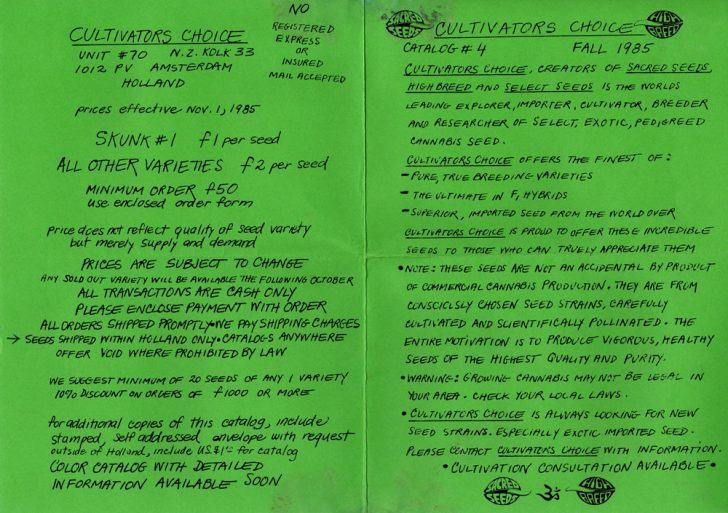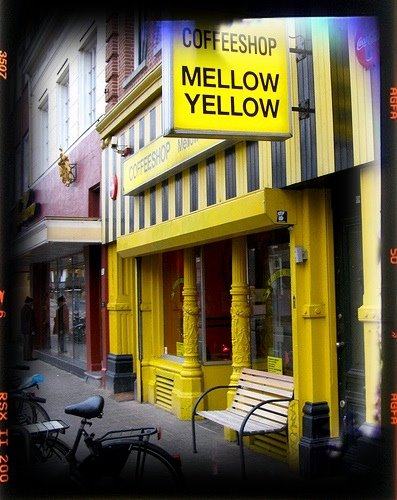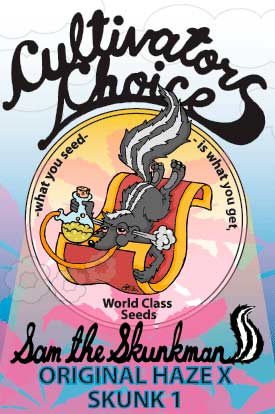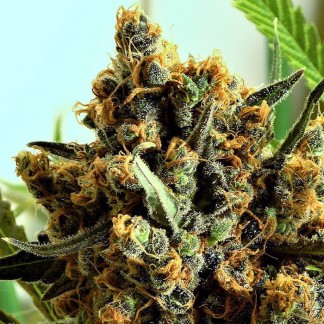More than 40 years ago, the Skunk marijuana variety was born, one of the most stable lines, considered one of the purest and most popular for making all types of crosses and hybrids. Its name in English means "skunk," a name given due to its potent smell, a very important factor to consider if we want to cultivate Skunk marijuana indoors, as it doesn't go unnoticed and we'll need to apply effective systems to eliminate marijuana odor.
With a composition of 75% Sativa and 25% Indica, it captures very well the characteristics of each of these marijuana varieties. It provides us with an exquisite aroma and flavor from its Sativa side, and a short flowering period of approximately two months, from its Indica side. All of this, offering an abundant central cola and thick branches with generous buds.
The comfort of its cultivation makes Skunk very popular and one of the most cultivated marijuana varieties, as it is chosen by both the most experienced and those who want to start in cannabis cultivation. Its robustness and resistance make it an ideal option for beginner growers, while its stable genetics allow experts to use it as a base to create new hybrid varieties.
History and Origin of Skunk: The California Pioneers
Its origin is found in California in the early 1970s, in a golden era for cannabis experimentation. Various creators are mentioned, some sources say the inventor was a single man, the famous Sam, The Skunkman. Others speak of a group of Sacred Seeds cultivators that Sam himself led. Either way, it's clear that they all worked to find and develop this new genetic line in a stable manner that would become the mother of many other varieties.
The historical context of the 1970s in California was crucial for Skunk's development. The hippie counterculture, the freedom movement, and experimentation with psychoactive plants created the perfect environment for these pioneers to work on creating new varieties. The search for stable and potent genetics became an obsession for many cultivators of the era.

Additionally, the fact that marijuana has had to deal with illegality according to different eras, countries, and commercial activities, always makes it more difficult to find documentation that accredits some of the events. This forced clandestinity has created an aura of mystery around the exact origins of many varieties, including Skunk.
The Work of Sacred Seeds: Science and Passion
Sacred Seeds was a collective of expert cultivators who, in the 1960s, began working with different genetic lines and focused on creating a stable line, the Skunk. Around those years, a man named Jingles from the Humboldt area, Bay Area, in northern California, had crossed Indica Afghanis with Colombian Gold and kept it private for years until it became popular in the area.
This first cross was the foundation upon which Sacred Seeds would build their masterpiece. The selection work was meticulous and scientific, using plant breeding techniques that were advanced for the time. Sacred Seeds cultivators weren't just looking for potency, but also genetic stability, disease resistance, and ease of cultivation.
Sacred Seeds began working on what would become Skunk #1, where they added the Acapulco Gold component that would make it more stable and provide more flower volume. The so-called Skunk #1, considered the original, is composed of 25% Indica (Afghanis), and 75% Sativa (25% Mexican Acapulco Gold and 50% Colombian Gold).
This genetic combination wasn't by chance. The cultivators knew that Sativa varieties provided cerebral potency and complex aromas, while Indica provided structure, floral density, and shorter flowering times. The perfect balance between these characteristics made Skunk #1 a revolution in the cannabis world.
After breeding hundreds of plants, a selection was made with the best females and the best males. Additionally, THC levels were analyzed, which rose to 15%, a considerably high concentration for the standards of the time. In 1977 they already had the first Skunk #1 seeds for sale and every year all stock was sold out.
The End of an Era and a New Beginning
Although Sacred Seeds' good run was short-lived, as in 1982 there was a police raid, Sacred Seeds had to close with Ronald Reagan's new policies. Reagan's "War on Drugs" intensified the persecution of cannabis cultivators, ending many pioneering projects like Sacred Seeds.
And Sam, who had been arrested and quickly released, moved to Amsterdam, a city where marijuana was somewhat more welcome, away from the strict prohibition they experienced in the United States. This fact determined an important expansion of Skunk at European and worldwide levels. In Holland they commercialized with hashish that came from Morocco but had never before managed to have a cultivation with such quality and the aroma and effect of the Skunk that Sam brought them.
Sam's arrival in Amsterdam coincided with the perfect moment in Dutch history. Coffee shops had just been legalized and there was a growing demand for high-quality cannabis. Skunk arrived at just the right time to satisfy this demand and establish new quality standards.
Sam, The Skunkman: The Man Behind the Legend
Who was behind one of the most relevant names in modern cannabis culture? Sam The Skunkman, actually, was called David Watson, and when he arrived in Holland he introduced himself as Sam Selezny. He himself always claimed to be the sole creator of the Skunk variety. He also stated on his own blog that it was false that he had been arrested and had been in jail.
The figure of Sam The Skunkman is surrounded by controversy and mystery. His enigmatic personality and often contradictory statements have fueled decades of speculation in the cannabis community. Some see him as a pioneering hero, while others question his methods and motivations.
Although on the other hand, some members of the former Sacred Seeds and other sources confirm that it was team work under his command, among other details. The day of the raid on his Sacred Seeds warehouse, he was arrested. However, he already had everything prepared with his lawyers and managed to get released within a few hours. That way, Sam returned to the warehouse where he recovered a large amount of material and managed to save many seeds and 10 years of work.
From California to Amsterdam: The Journey That Changed European Cannabis

Just one month after getting out of jail, Sam, the Skunkman, was invited by Wernard Bruining, the owner of the first coffee shop Mellow Yellow and Ed Roshental, editor-in-chief of the cultivation section of High Times magazine. Soon, Sam would start working as an editor and also in Wernard's grow and coffee shop, where it was allowed to sell marijuana and hashish since 1976.
The collaboration between Sam and these European cannabis pioneers was fundamental in establishing the foundations of the modern cannabis industry. The knowledge transfer from California to Europe marked the beginning of a new era in cannabis cultivation and commercialization.
Years later, Sam proposed to High Times magazine to organize a cup championship in the style of Santa Cruz, California, and in 1988 the first High Times Cannabis Cup was held. The winner of the competition was the Skunk #1 variety from Sam The Skunkman's seed bank. Its aroma, flavor, and effect captivated the market for the long term.
This victory in the first Cannabis Cup not only validated the quality of Skunk #1, but also established the standard for all future competitions. The event became the Olympics of cannabis, and winning meant worldwide recognition.
In Holland, Sam sold the first seeds under the Cultivators Choice label. Another part of the seeds were bought by Neville Shoenmakers, owner of The Seed Bank seed bank. It remains a mystery today how he did it, but Sam managed to leave the United States with 250,000 seeds.

The Evolution of Skunk: Two Divergent Paths
From this distribution of Skunk, each bank worked on its own version, thus giving way to two variations of Skunk #1. On one hand, Sam's bank obtained the "Sweet Skunk" line, with a softer and sweeter aroma, with a calmer effect, typical of Sativa, so as not to be destroyed after the high.
Sweet Skunk represented a more refined evolution of the original genetics, oriented towards an audience seeking more functional effects and more appealing aromas. This line became the favorite of many commercial cultivators due to its olfactory discretion and balanced effect.
While Neville's bank evolved with the "Roadkill Skunk" version that has the characteristics of Afghan Indica with a more intense aroma and a relaxing effect, known as "couchlock," which comes from being glued to the couch and helps with sleep.
Roadkill Skunk maintained the original essence of the genetics, with that penetrating aroma that gave the variety its name. This line became the favorite of connoisseurs who sought the authentic Skunk experience.
The Controversial Legacy and the Future
Today it is still believed that Sam (David Watson) has always collaborated with the DEA to filter information and denounce other cultivators and commercial and illegal cannabis activities. This accusation, although it has never been definitively proven, has cast a shadow over his legacy and has divided the cannabis community.
Despite the controversies, it is undeniable that Skunk has been fundamental in the development of the modern cannabis industry. Its stable genetics and unique characteristics have made it the basis of hundreds of hybrid varieties that dominate today's market.
Cultural and Social Impact
Skunk not only revolutionized cannabis genetics, but also had a significant impact on popular culture. Its name became synonymous with high-quality cannabis, and its distinctive aroma was associated with the authentic cannabis experience.
The variety also played a crucial role in the evolution of Dutch coffee shops, establishing quality standards that persist to this day. Its commercial success demonstrated that there was a market for high-quality cannabis, laying the foundations for today's multimillion-dollar industry.
The Skunk variety continues to be one of the most popular options for both beginner and experienced growers, demonstrating that good genetics transcend trends and become timeless classics.


